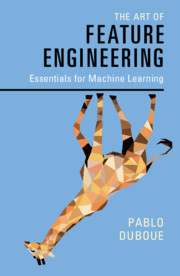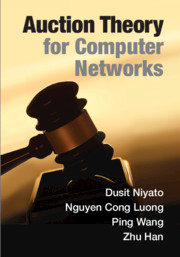Refine search
Actions for selected content:
6791 results in Communications and signal processing
Contents
-
- Book:
- Auction Theory for Computer Networks
- Published online:
- 15 May 2020
- Print publication:
- 11 June 2020, pp vii-x
-
- Chapter
- Export citation

The Art of Feature Engineering
- Essentials for Machine Learning
-
- Published online:
- 29 May 2020
- Print publication:
- 25 June 2020

Auction Theory for Computer Networks
-
- Published online:
- 15 May 2020
- Print publication:
- 11 June 2020
Part II - Applications
-
- Book:
- Communication Complexity
- Published online:
- 30 January 2020
- Print publication:
- 20 February 2020, pp 155-156
-
- Chapter
- Export citation
11 - Data Structures
- from Part II - Applications
-
- Book:
- Communication Complexity
- Published online:
- 30 January 2020
- Print publication:
- 20 February 2020, pp 187-209
-
- Chapter
- Export citation
Dedication
-
- Book:
- Communication Complexity
- Published online:
- 30 January 2020
- Print publication:
- 20 February 2020, pp v-vi
-
- Chapter
- Export citation
13 - Distributed Computing
- from Part II - Applications
-
- Book:
- Communication Complexity
- Published online:
- 30 January 2020
- Print publication:
- 20 February 2020, pp 239-243
-
- Chapter
- Export citation
10 - Memory Size
- from Part II - Applications
-
- Book:
- Communication Complexity
- Published online:
- 30 January 2020
- Print publication:
- 20 February 2020, pp 175-186
-
- Chapter
- Export citation
Introduction
-
- Book:
- Communication Complexity
- Published online:
- 30 January 2020
- Print publication:
- 20 February 2020, pp 1-6
-
- Chapter
- Export citation
3 - Randomized Protocols
- from Part I - Communication
-
- Book:
- Communication Complexity
- Published online:
- 30 January 2020
- Print publication:
- 20 February 2020, pp 46-56
-
- Chapter
- Export citation
6 - Information
- from Part I - Communication
-
- Book:
- Communication Complexity
- Published online:
- 30 January 2020
- Print publication:
- 20 February 2020, pp 93-120
-
- Chapter
- Export citation
12 - Extension Complexity of Polytopes
- from Part II - Applications
-
- Book:
- Communication Complexity
- Published online:
- 30 January 2020
- Print publication:
- 20 February 2020, pp 210-238
-
- Chapter
- Export citation
Conventions and Preliminaries
-
- Book:
- Communication Complexity
- Published online:
- 30 January 2020
- Print publication:
- 20 February 2020, pp xiii-xviii
-
- Chapter
- Export citation
Frontmatter
-
- Book:
- Communication Complexity
- Published online:
- 30 January 2020
- Print publication:
- 20 February 2020, pp i-iv
-
- Chapter
- Export citation
Bibliography
-
- Book:
- Communication Complexity
- Published online:
- 30 January 2020
- Print publication:
- 20 February 2020, pp 244-249
-
- Chapter
- Export citation
1 - Deterministic Protocols
- from Part I - Communication
-
- Book:
- Communication Complexity
- Published online:
- 30 January 2020
- Print publication:
- 20 February 2020, pp 9-32
-
- Chapter
- Export citation
Part I - Communication
-
- Book:
- Communication Complexity
- Published online:
- 30 January 2020
- Print publication:
- 20 February 2020, pp 7-8
-
- Chapter
- Export citation
Preface
-
- Book:
- Communication Complexity
- Published online:
- 30 January 2020
- Print publication:
- 20 February 2020, pp xi-xii
-
- Chapter
- Export citation
4 - Numbers on Foreheads
- from Part I - Communication
-
- Book:
- Communication Complexity
- Published online:
- 30 January 2020
- Print publication:
- 20 February 2020, pp 57-66
-
- Chapter
- Export citation
Contents
-
- Book:
- Communication Complexity
- Published online:
- 30 January 2020
- Print publication:
- 20 February 2020, pp vii-x
-
- Chapter
- Export citation
